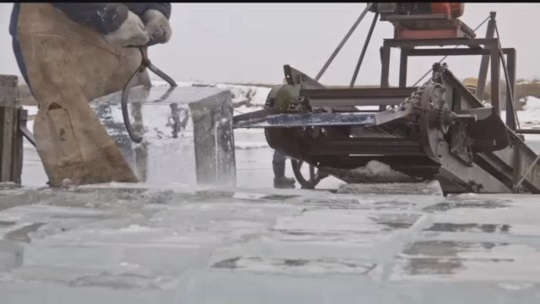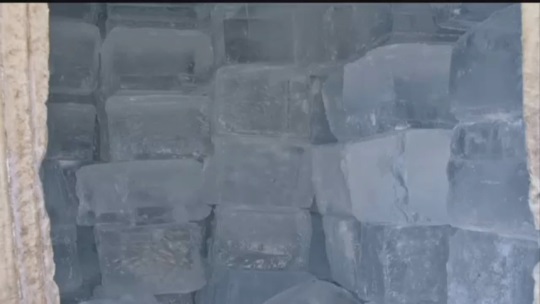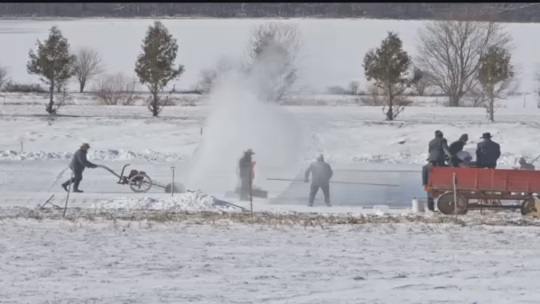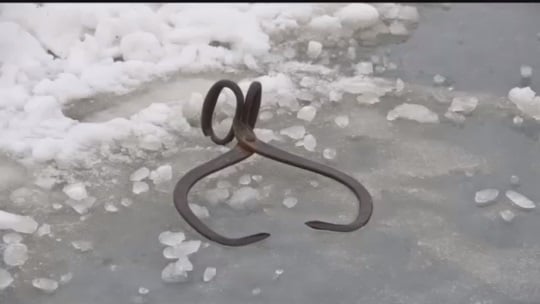Ice Cutting in Amish Iowa (9 Photos)

Photographer David Marvitz has captured some striking images of Amish doing an important winter chore in Iowa.
While many Amish use propane or natural gas-powered refrigerators to keep food cold (see point #4 here), the more traditional Amish use ice houses.

This is prime time to collect frozen fuel for these structures, which keep food chilled well into the warmer months.
Here’s what those ice blocks look like stacked up inside an ice house:

You can see photos of another ice house here, showing the ice cooling yogurt and hot dogs.
The ice is also used for making homemade ice cream.
The community here is near Hazelton in Buchanan County. Marvitz was invited to take shots on a recent ice harvest day.
Marvitz says that thanks to their close relationship, the Amish trust him, leading to their openness to his photography.

In a video by KWWL, you can see a selection of the photos Marvitz took.
You’ll also hear him describe getting the call to document the event, on a day which saw a minus 21-degree wind chill.
Some other shots by Marvitz. Here’s a “homemade ice cutter”:

Tongs for gripping the frozen chunks:

A pitchfork comes in handy:

A hay elevator moves the bulky blocks…

…which are then stacked on a wagon for transport.

As you might expect, this job has its hazards. In 2013 an Amish teen drowned in Wisconsin while cutting ice.
Other places where Amish harvest ice include Green Lake County, WI, Knox County, OH, and Heuvelton, NY.
Neat to get a window onto a once-common but now obscure job, still being done in the plainer corners of Amish society.






Equipment
Amish farm equipment is very functional, and always repairable. With the help of others, farm tasks become an easier chore.
Wow, I don’t think I would like that job. I think I would rely on drying and canning for preservation and learn to like lukewarm.
Good looking ice
That ice will last through the summer in a well built ice shed. The ice looks very clear.
I have seen it harvested at a preserved 1890’s living farm in West Chicago, Illinois called Kline Creek Farm. They will be harvesting ice January 26-28th 2018(starting tomorrow)1-4pm each day. They use equipment from the late 1800’s. Real saws,wagons and horses – No gas engines.
"Cool" & dangerous
In my area (Cary, IL) ice cutting was similarly done on the nearby Fox River in the 1890’s. Photos of the operation are in a history of the area I had a part in writing back in 1993, our centennial year.
In the past couple of years, I got to see (at least the outside of) an ice house in the Shipshewana, IN area. It resembled a concrete bunker. I have no doubt that if well-stocked (and not TOO hot a summer), the ice would last for months.
The job certainly has its dangers. I cringe when seeing those hefty horses walking on the ice. I was saddened, though not surprised, at the death of that teenage boy who was cutting ice a few years back. My heart goes out to the family & community!
Alice Mary
On the AA Facebook page, a woman named Peggy Woods who is a neighbor to the family of the boy in WI who drowned shared the story. Sounds like the family is still struggling with their loss.
https://www.facebook.com/amishamerica/posts/1602860379774402
Ice Cutting
My mom grew up in the Depression using iceboxes, and often described to me the fun of running down the street begging chips of ice off the wagons from the delivery man. Iceboxes work quite well, so it’s nice to see ice-cutting still in action — although yes, it’s obviously dangerous!
There used to be, at least, a restaurant in Fort Worth near where my grandmother lived that was built in an old icehouse. The original structure showed the thickness of the walls; I imagine that in Texas, a place like that stored ice for a whole community, it was so large. Very impressive! Those who don’t use powered refrigeration these days still know how to use what for my mom and grandparents was still a common way to live.
Simpler times, when ice got children excited…I won’t nostalgize the past and say those were necessarily *better* times (for one I am glad for things like modern medicine, vastly reduced poverty and increased lifespans), but there is something to that idea of simple fun.
Hard to imagine something like that today when kids begin getting trained onto electronic entertainment at age…2? Or whenever it is they get their first tablet anyway 😀
Ice in PA - Mifflin County
Last summer I went to a Nebraska Amish farm (auction) and noticed several square stainless steel “buckets”. I was told they were filled with water and when the froze solid the ice was removed and stored in the ice house bunker which was insulated with 16 inch thick Styrofoam panels.
Ice buckets
Sounds like a good plan B if you’re not able to organize a proper full ice harvest day.
Great photos! I wish I’d known about this…just 30 minutes from me. I visit this community often.
Does it seem like a very plain community to you Denise? It had been described in that way in the past, but one reader left a comment several years ago painting a picture of a community which was in between conservative and progressive. An excerpt:
https://amishamerica.com/in-the-kitchen-with-the-amish-iowa/#comment-105548
They have been excluded by most conservative Amish groups because of their openness to technological change. So they are presently stuck somewhere between the Dan/Andy Weaver Amish and the Lancaster (Streng Meidung but technologically progressive) type, lacking the intricate ties of fellowship that link places like Lawrence Co. (PA) and Fredericktown (OH) to many other settlements. But for someone who hangs out in Lancaster County most of the time, a visit to Buchanan County would seem like a step back in time.